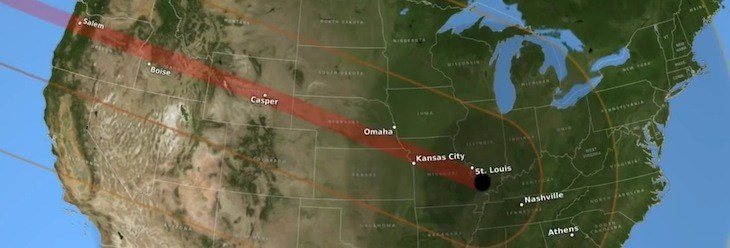Arkansas State University team will study solar eclipse in August, part of NASA project
by July 24, 2017 7:51 pm 615 views

The chance to view a total solar eclipse can be a once-in-a lifetime event, and a group from Arkansas State University will journey to Missouri in August to view one. Science education professor Dr. Tillman Kennon will take about a dozen ASU students to Fulton, Mo., on Aug. 21 to gather data during the eclipse. The data will be collected as part of a NASA study of the event.
Kennon, the students and associate professor of physics Dr. Ross Carroll have prepared for the eclipse for more than a year. Arkansas will only experience a partial eclipse, which made it necessary for the team to travel to central Missouri, where they hope to launch a pair of high-altitude balloons carrying various instruments to study the phenomenon. (Link here for the NASA website devoted to the eclipse.)
The balloons will reach altitudes that approach 100,000 feet – higher than 98% of the Earth’s atmosphere, and high enough the sky will appear black instead of blue. The balloons will carry multiple cameras, tracking devices, and other instruments such as spectrometers and Geiger counters.
“Our record is just under 104,000 feet, and we have flown 49 times from Arkansas starting in 2006,” Kennon said. “The average is about 90,000 feet, but we’ve got a different balloon now and it seems like the average is getting higher. We put a little less than two of the big cylinders of helium in it, and it will be 8-10 feet in diameter.”
A solar eclipse occurs when the moon moves between the sun and the earth, blocking out the sun’s light and casting a shadow on the surface of the earth. Carroll said as the balloon rises and air pressure decreases, it will expand to 30-40 feet in diameter before it bursts or is cut free.
“We have a device called a cutdown that fastens between the parachute and the balloon, and we can actually send a signal from our ground station to cut the line, so that if we needed to we could bring it down sooner. Up until now, we just kind of let it go and waited until it bursts,” he said.
Although surface winds can be troublesome when filling the balloon, once it is up and clear of any obstructions, drift is minimal.
“The wind direction changes back and forth all the way up,” said Kennon. “Once it gets up to about 60,000 feet, there is essentially no wind. To get to the apex takes about an hour and 15 minutes.”
The final test launch was performed July 23. The launch was a success, with the equipment reaching an altitude of about 95,000 feet. It was tracked by a ground station eight miles from the launch site.
“The entire team did an incredible job under very hot conditions. This was our first launch where the launch site and the ground station were not at the same location and with the exception of a few glitches, everything worked as planned,” he said.
While the team has been training, timing has not been an issue, but because the eclipse will occur midday, the release time is critical. Once aloft, multiple still and video cameras will record the eclipse.
“The whole NASA objective, and there will be about 50 teams like us across the country, is to have it live, with the cameras not only seeing the sun, but seeing the shadow as it goes across the United States,” Kennon said. “Anything else we do is just icing on the cake.”
The balloon’s payload will not only include cameras and scientific instruments, but communication devices as well. Communication tools aboard will include a pair of ham radios with GPS units and a device that communicates with the Iridium satellite constellation, which is an array of 66 communications satellites currently in orbit.
Although totality will not be visible in Northeast Arkansas, Kennon said students should be able to view a 90-95% eclipse, and strongly cautioned against watching it with the naked eye. Kennon said the best way to view the eclipse is with special glasses made especially for that purpose. He recommends glasses that filter out 100% of ultraviolet and infrared rays. He cautioned that smoked glass, welding hoods and lesser quality viewing glasses that do not block out 100% of harmful rays are not adequate for protection.
“The partial part of the eclipse that we see here will last almost two hours, and it will get noticeably darker outside,” said Kennon. “As the moon covers more and more of the sun, even though it may not feel like it, the infrared and UV rays from the sun can damage your eyes.”
The eclipse will begin shortly before noon and be at its fullest phase between 1-1:30 p.m. After that, the U.S. will have to wait until 2024 for the next one. Much of the northern half of Arkansas will fall in the area of total eclipse in 2024, and also for the next one in 2045. To view this year’s eclipse in totality, people in Northeast Arkansas should drive 45 miles north of Sikeston, Mo.
“Kids today don’t realize how fortunate they are to be alive at just the right time, because the last time an eclipse went through Arkansas and all the way across the United States was in 1918,” Kennon said. “Pretty much, if they stay anywhere in the USA, they would have an opportunity to see three total eclipses in about a 35-year span.”
